【RabbitMQ】 RabbitMQ安装
MQ全称为Message Queue, 消息队列(MQ)是一种应用程序对应用程序的通信方法。应用程序通过读写出入队列的消息(针对应用程序的数据)来通信,而无需专用连接来链接它们。消息传递指的是程序之间通过在消息中发送数据进行通信,而不是通过直接调用彼此来通信,直接调用通常是用于诸如远程过程调用的技术。排队指的是应用程序通过 队列来通信。队列的使用除去了接收和发送应用程序同时执行的要求
Linux下安装RabbitMQ
环境:Linux(CentOS 7.2)
1、安装Erlang环境,Erlang版本是21.1。参考【Erlang】源码安装
2、下载源码包(rabbitmq-server-generic-unix-3.7.9.tar.xz),版本:3.7.9
下载地址:https://www.rabbitmq.com/download.html
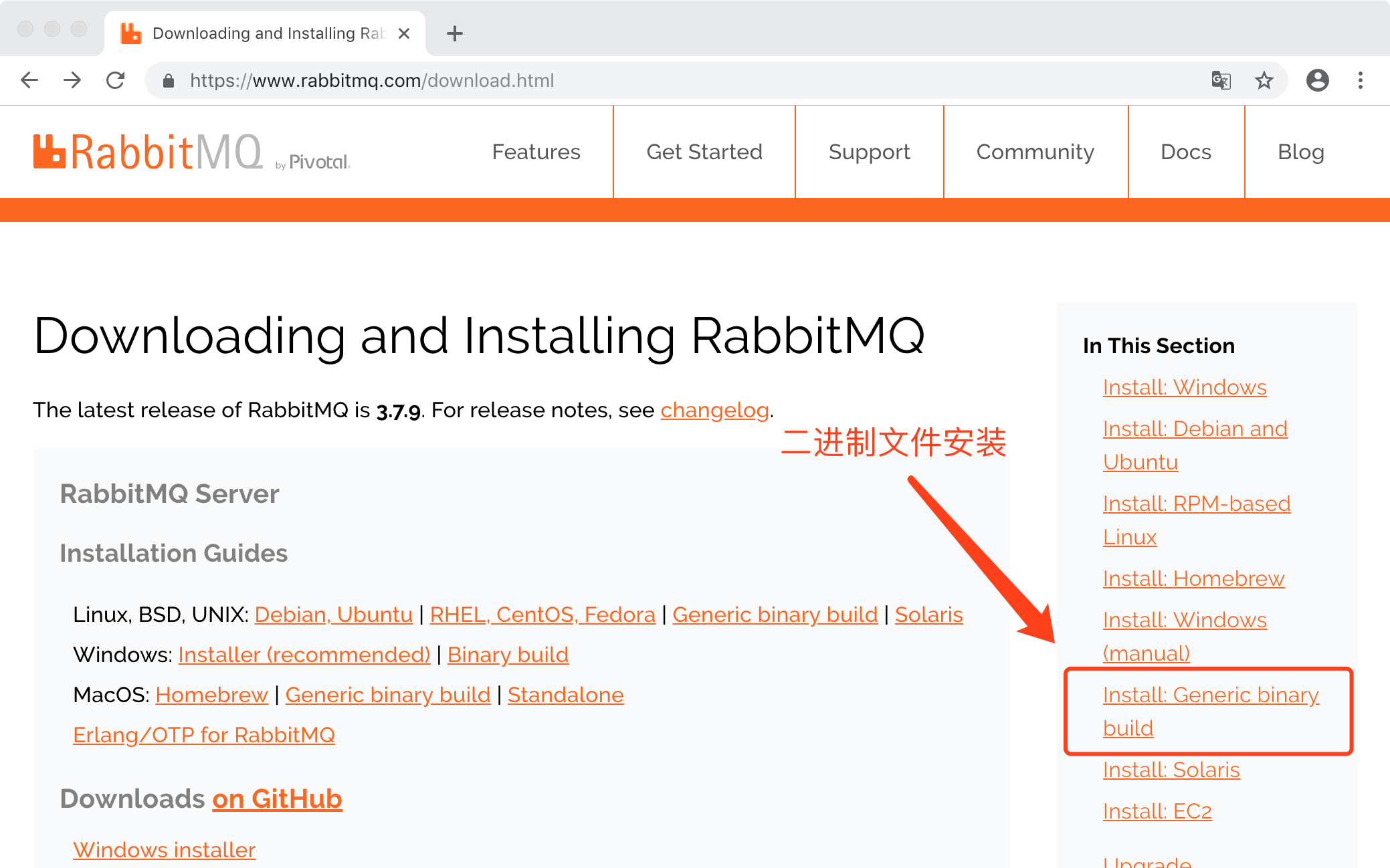
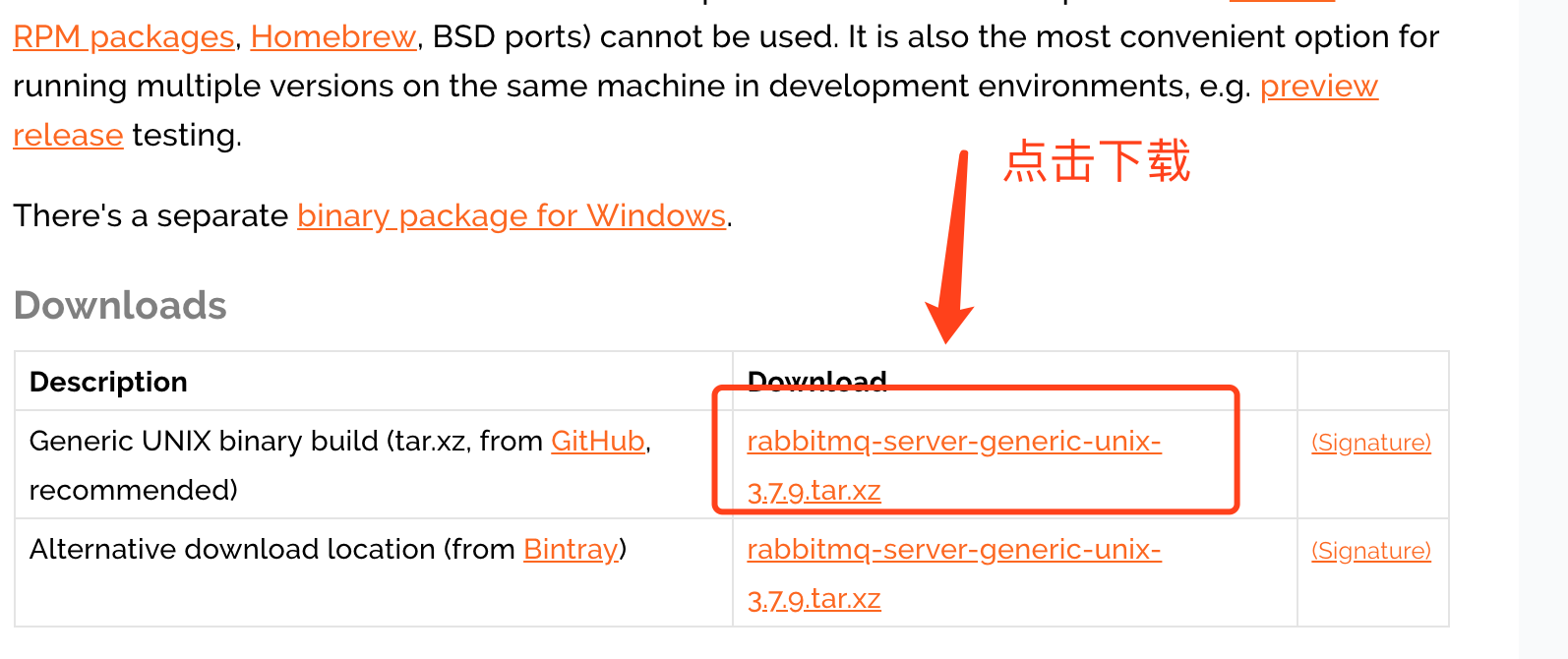
3、解压,命令:tar -xvf rabbitmq-server-generic-unix-3.7.9.tar.xz,解压后文件目录如下:
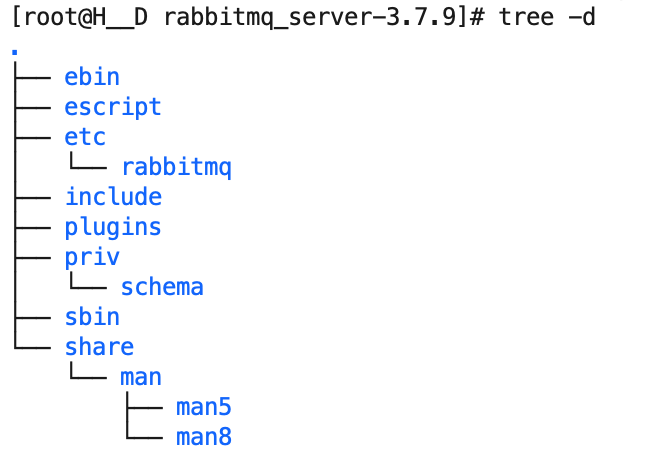
其中sbin目录下文件说明:
rabbitmq-env // 环境配置脚本
rabbitmq-defaults // 默认参数设置脚本
rabbitmqctl // 管理工具脚本
rabbitmq-plugins // 插件管理工具脚本
rabbitmq-server // rabbitmq服务脚本
4、可以自由拷贝解压后的文件到的制定目录,然后配置环境变量
a、编辑文件/etc/profile,命令:vim /etc/profile;增加如下内容:
export RABBIT_HOME=/data/soft/rabbitmq_server-3.7.9
export PATH=$RABBIT_HOME/sbin:$PATH
b、使环境变量生效,命令:source /etc/profile。
5、操作服务,启动默认监听端口:5672
启动服务(前台启动):rabbitmq-server start
启动服务(后台启动):rabbitmq-server start -detached
重启服务:rabbitmq-server restart
关闭服务:rabbitmqctl stop
查看服务状态:rabbitmqctl status
查看mq用户:rabbitmqctl list_users
查看用户权限:rabbitmqctl list_user_permissions guest
新增用户: rabbitmqctl add_user admin 123456
赋予管理员权限:rabbitmqctl set_user_tags admin administrator
分配权限:rabbitmqctl set_permissions -p / admin '.*' '.*' '.*'
效果图如下:
a、启动命令

b、查看状态

c、查看日志配置文件为空

注意:a、启动报错:Error description: noproc。
解决方案:Erlang版本和RabbitMQ不支持的原因,应该安装对应版本。参考地址:https://www.rabbitmq.com/which-erlang.html
6、启用插件,RabbitMQ的web控制台,命令:rabbitmq-plugins enable rabbitmq_management,然后重启RabbitMQ服务

7、浏览器输入http://ip:15672,端口是15672,访问RabbitMQ的web控制台,默认用户名/密码:guest/guest。
默认情况下,RabbitMQ的默认的guest用户只允许本机访问
由于不是在本机上访问报错,如下:
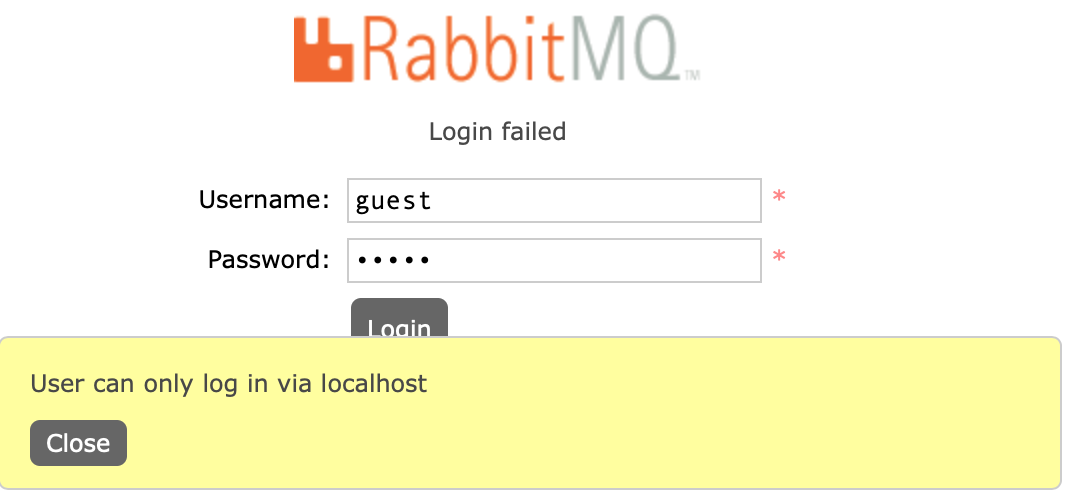
8、通过 find / -name rabbitmq-defaults 查找rabbitmq-defaults文件(/data/soft/rabbitmq_server-3.7.9/sbin/rabbitmq-defaults),查看config文件的存储路径
a、下载模版,配置文件模版下载:https://github.com/rabbitmq/rabbitmq-server/blob/master/docs/rabbitmq.conf.example
# ======================================
# RabbitMQ broker section
# ====================================== ## Related doc guide: http://rabbitmq.com/configure.html. See
## http://rabbitmq.com/documentation.html for documentation ToC. ## Networking
## ====================
##
## Related doc guide: http://rabbitmq.com/networking.html.
##
## By default, RabbitMQ will listen on all interfaces, using
## the standard (reserved) AMQP 0-9-1 and 1.0 port.
##
# listeners.tcp.default = 5672 ## To listen on a specific interface, provide an IP address with port.
## For example, to listen only on localhost for both IPv4 and IPv6:
##
# IPv4
# listeners.tcp.local = 127.0.0.1:5672
# IPv6
# listeners.tcp.local_v6 = ::1:5672 ## You can define multiple listeners using listener names
# listeners.tcp.other_port = 5673
# listeners.tcp.other_ip = 10.10.10.10:5672 ## TLS listeners are configured in the same fashion as TCP listeners,
## including the option to control the choice of interface.
##
# listeners.ssl.default = 5671 ## Number of Erlang processes that will accept connections for the TCP
## and TLS listeners.
##
# num_acceptors.tcp = 10
# num_acceptors.ssl = 1 ## Maximum time for AMQP 0-8/0-9/0-9-1 handshake (after socket connection
## and TLS handshake), in milliseconds.
##
# handshake_timeout = 10000 ## Set to 'true' to perform reverse DNS lookups when accepting a
## connection. Hostnames will then be shown instead of IP addresses
## in rabbitmqctl and the management plugin.
##
# reverse_dns_lookups = true ##
## Security, Access Control
## ==============
## ## Related doc guide: http://rabbitmq.com/access-control.html. ## The default "guest" user is only permitted to access the server
## via a loopback interface (e.g. localhost).
## {loopback_users, [<<"guest">>]},
##
# loopback_users.guest = true ## Uncomment the following line if you want to allow access to the
## guest user from anywhere on the network.
# loopback_users.guest = false ## TLS configuration.
##
## Related doc guide: http://rabbitmq.com/ssl.html.
##
# ssl_options.verify = verify_peer
# ssl_options.fail_if_no_peer_cert = false
# ssl_options.cacertfile = /path/to/cacert.pem
# ssl_options.certfile = /path/to/cert.pem
# ssl_options.keyfile = /path/to/key.pem
#
# ssl_options.honor_cipher_order = true
# ssl_options.honor_ecc_order = true # ssl_options.ciphers.1 = ECDHE-ECDSA-AES256-GCM-SHA384
# ssl_options.ciphers.2 = ECDHE-RSA-AES256-GCM-SHA384
# ssl_options.ciphers.3 = ECDHE-ECDSA-AES256-SHA384
# ssl_options.ciphers.4 = ECDHE-RSA-AES256-SHA384
# ssl_options.ciphers.5 = ECDH-ECDSA-AES256-GCM-SHA384
# ssl_options.ciphers.6 = ECDH-RSA-AES256-GCM-SHA384
# ssl_options.ciphers.7 = ECDH-ECDSA-AES256-SHA384
# ssl_options.ciphers.8 = ECDH-RSA-AES256-SHA384
# ssl_options.ciphers.9 = DHE-RSA-AES256-GCM-SHA384
# ssl_options.ciphers.10 = DHE-DSS-AES256-GCM-SHA384
# ssl_options.ciphers.11 = DHE-RSA-AES256-SHA256
# ssl_options.ciphers.12 = DHE-DSS-AES256-SHA256
# ssl_options.ciphers.13 = ECDHE-ECDSA-AES128-GCM-SHA256
# ssl_options.ciphers.14 = ECDHE-RSA-AES128-GCM-SHA256
# ssl_options.ciphers.15 = ECDHE-ECDSA-AES128-SHA256
# ssl_options.ciphers.16 = ECDHE-RSA-AES128-SHA256
# ssl_options.ciphers.17 = ECDH-ECDSA-AES128-GCM-SHA256
# ssl_options.ciphers.18 = ECDH-RSA-AES128-GCM-SHA256
# ssl_options.ciphers.19 = ECDH-ECDSA-AES128-SHA256
# ssl_options.ciphers.20 = ECDH-RSA-AES128-SHA256
# ssl_options.ciphers.21 = DHE-RSA-AES128-GCM-SHA256
# ssl_options.ciphers.22 = DHE-DSS-AES128-GCM-SHA256
# ssl_options.ciphers.23 = DHE-RSA-AES128-SHA256
# ssl_options.ciphers.24 = DHE-DSS-AES128-SHA256
# ssl_options.ciphers.25 = ECDHE-ECDSA-AES256-SHA
# ssl_options.ciphers.26 = ECDHE-RSA-AES256-SHA
# ssl_options.ciphers.27 = DHE-RSA-AES256-SHA
# ssl_options.ciphers.28 = DHE-DSS-AES256-SHA
# ssl_options.ciphers.29 = ECDH-ECDSA-AES256-SHA
# ssl_options.ciphers.30 = ECDH-RSA-AES256-SHA
# ssl_options.ciphers.31 = ECDHE-ECDSA-AES128-SHA
# ssl_options.ciphers.32 = ECDHE-RSA-AES128-SHA
# ssl_options.ciphers.33 = DHE-RSA-AES128-SHA
# ssl_options.ciphers.34 = DHE-DSS-AES128-SHA
# ssl_options.ciphers.35 = ECDH-ECDSA-AES128-SHA
# ssl_options.ciphers.36 = ECDH-RSA-AES128-SHA ## Select an authentication/authorisation backend to use.
##
## Alternative backends are provided by plugins, such as rabbitmq-auth-backend-ldap.
##
## NB: These settings require certain plugins to be enabled.
##
## Related doc guides:
##
## * http://rabbitmq.com/plugins.html
## * http://rabbitmq.com/access-control.html
## # auth_backends.1 = rabbit_auth_backend_internal ## uses separate backends for authentication and authorisation,
## see below.
# auth_backends.1.authn = rabbit_auth_backend_ldap
# auth_backends.1.authz = rabbit_auth_backend_internal ## The rabbitmq_auth_backend_ldap plugin allows the broker to
## perform authentication and authorisation by deferring to an
## external LDAP server.
##
## Relevant doc guides:
##
## * http://rabbitmq.com/ldap.html
## * http://rabbitmq.com/access-control.html
##
## uses LDAP for both authentication and authorisation
# auth_backends.1 = rabbit_auth_backend_ldap ## uses HTTP service for both authentication and
## authorisation
# auth_backends.1 = rabbit_auth_backend_http ## uses two backends in a chain: HTTP first, then internal
# auth_backends.1 = rabbit_auth_backend_http
# auth_backends.2 = rabbit_auth_backend_internal ## Authentication
## The built-in mechanisms are 'PLAIN',
## 'AMQPLAIN', and 'EXTERNAL' Additional mechanisms can be added via
## plugins.
##
## Related doc guide: http://rabbitmq.com/authentication.html.
##
# auth_mechanisms.1 = PLAIN
# auth_mechanisms.2 = AMQPLAIN ## The rabbitmq-auth-mechanism-ssl plugin makes it possible to
## authenticate a user based on the client's x509 (TLS) certificate.
## Related doc guide: http://rabbitmq.com/authentication.html.
##
## To use auth-mechanism-ssl, the EXTERNAL mechanism should
## be enabled:
##
# auth_mechanisms.1 = PLAIN
# auth_mechanisms.2 = AMQPLAIN
# auth_mechanisms.3 = EXTERNAL ## To force x509 certificate-based authentication on all clients,
## exclude all other mechanisms (note: this will disable password-based
## authentication even for the management UI!):
##
# auth_mechanisms.1 = EXTERNAL ## This pertains to both the rabbitmq-auth-mechanism-ssl plugin and
## STOMP ssl_cert_login configurations. See the RabbitMQ STOMP plugin
## configuration section later in this file and the README in
## https://github.com/rabbitmq/rabbitmq-auth-mechanism-ssl for further
## details.
##
## To use the TLS cert's CN instead of its DN as the username
##
# ssl_cert_login_from = common_name ## TLS handshake timeout, in milliseconds.
##
# ssl_handshake_timeout = 5000 ## Password hashing implementation. Will only affect newly
## created users. To recalculate hash for an existing user
## it's necessary to update her password.
##
## To use SHA-512, set to rabbit_password_hashing_sha512.
##
# password_hashing_module = rabbit_password_hashing_sha256 ## When importing definitions exported from versions earlier
## than 3.6.0, it is possible to go back to MD5 (only do this
## as a temporary measure!) by setting this to rabbit_password_hashing_md5.
##
# password_hashing_module = rabbit_password_hashing_md5 ##
## Default User / VHost
## ====================
## ## On first start RabbitMQ will create a vhost and a user. These
## config items control what gets created.
## Relevant doc guide: http://rabbitmq.com/access-control.html
##
# default_vhost = /
# default_user = guest
# default_pass = guest # default_permissions.configure = .*
# default_permissions.read = .*
# default_permissions.write = .* ## Tags for default user
##
## For more details about tags, see the documentation for the
## Management Plugin at http://rabbitmq.com/management.html.
##
# default_user_tags.administrator = true ## Define other tags like this:
# default_user_tags.management = true
# default_user_tags.custom_tag = true ##
## Additional network and protocol related configuration
## =====================================================
## ## Set the default AMQP 0-9-1 heartbeat interval (in seconds).
## Related doc guides:
##
## * http://rabbitmq.com/heartbeats.html
## * http://rabbitmq.com/networking.html
##
# heartbeat = 60 ## Set the max permissible size of an AMQP frame (in bytes).
##
# frame_max = 131072 ## Set the max frame size the server will accept before connection
## tuning occurs
##
# initial_frame_max = 4096 ## Set the max permissible number of channels per connection.
## 0 means "no limit".
##
# channel_max = 128 ## Customising TCP Listener (Socket) Configuration.
##
## Related doc guides:
##
## * http://rabbitmq.com/networking.html
## * http://www.erlang.org/doc/man/inet.html#setopts-2
## # tcp_listen_options.backlog = 128
# tcp_listen_options.nodelay = true
# tcp_listen_options.exit_on_close = false
#
# tcp_listen_options.keepalive = true
# tcp_listen_options.send_timeout = 15000
#
# tcp_listen_options.buffer = 196608
# tcp_listen_options.sndbuf = 196608
# tcp_listen_options.recbuf = 196608 ##
## Resource Limits & Flow Control
## ==============================
##
## Related doc guide: http://rabbitmq.com/memory.html. ## Memory-based Flow Control threshold.
##
# vm_memory_high_watermark.relative = 0.4 ## Alternatively, we can set a limit (in bytes) of RAM used by the node.
##
# vm_memory_high_watermark.absolute = 1073741824 ## Or you can set absolute value using memory units (with RabbitMQ 3.6.0+).
## Absolute watermark will be ignored if relative is defined!
##
# vm_memory_high_watermark.absolute = 2GB
##
## Supported units suffixes:
##
## kb, KB: kibibytes (2^10 bytes)
## mb, MB: mebibytes (2^20)
## gb, GB: gibibytes (2^30) ## Fraction of the high watermark limit at which queues start to
## page message out to disc in order to free up memory.
## For example, when vm_memory_high_watermark is set to 0.4 and this value is set to 0.5,
## paging can begin as early as when 20% of total available RAM is used by the node.
##
## Values greater than 1.0 can be dangerous and should be used carefully.
##
## One alternative to this is to use durable queues and publish messages
## as persistent (delivery mode = 2). With this combination queues will
## move messages to disk much more rapidly.
##
## Another alternative is to configure queues to page all messages (both
## persistent and transient) to disk as quickly
## as possible, see http://rabbitmq.com/lazy-queues.html.
##
# vm_memory_high_watermark_paging_ratio = 0.5 ## Selects Erlang VM memory consumption calculation strategy. Can be `allocated`, `rss` or `legacy` (aliased as `erlang`),
## Introduced in 3.6.11. `rss` is the default as of 3.6.12.
## See https://github.com/rabbitmq/rabbitmq-server/issues/1223 and rabbitmq/rabbitmq-common#224 for background.
# vm_memory_calculation_strategy = rss ## Interval (in milliseconds) at which we perform the check of the memory
## levels against the watermarks.
##
# memory_monitor_interval = 2500 ## The total memory available can be calculated from the OS resources
## - default option - or provided as a configuration parameter.
# total_memory_available_override_value = 2GB ## Set disk free limit (in bytes). Once free disk space reaches this
## lower bound, a disk alarm will be set - see the documentation
## listed above for more details.
##
## Absolute watermark will be ignored if relative is defined!
# disk_free_limit.absolute = 50000 ## Or you can set it using memory units (same as in vm_memory_high_watermark)
## with RabbitMQ 3.6.0+.
# disk_free_limit.absolute = 500KB
# disk_free_limit.absolute = 50mb
# disk_free_limit.absolute = 5GB ## Alternatively, we can set a limit relative to total available RAM.
##
## Values lower than 1.0 can be dangerous and should be used carefully.
# disk_free_limit.relative = 2.0 ##
## Clustering
## =====================
##
# cluster_partition_handling = ignore ## pause_if_all_down strategy require additional configuration
# cluster_partition_handling = pause_if_all_down ## Recover strategy. Can be either 'autoheal' or 'ignore'
# cluster_partition_handling.pause_if_all_down.recover = ignore ## Node names to check
# cluster_partition_handling.pause_if_all_down.nodes.1 = rabbit@localhost
# cluster_partition_handling.pause_if_all_down.nodes.2 = hare@localhost ## Mirror sync batch size, in messages. Increasing this will speed
## up syncing but total batch size in bytes must not exceed 2 GiB.
## Available in RabbitMQ 3.6.0 or later.
##
# mirroring_sync_batch_size = 4096 ## Make clustering happen *automatically* at startup. Only applied
## to nodes that have just been reset or started for the first time.
##
## Relevant doc guide: http://rabbitmq.com//cluster-formation.html
## # cluster_formation.peer_discovery_backend = rabbit_peer_discovery_classic_config
#
# cluster_formation.classic_config.nodes.1 = rabbit1@hostname
# cluster_formation.classic_config.nodes.2 = rabbit2@hostname
# cluster_formation.classic_config.nodes.3 = rabbit3@hostname
# cluster_formation.classic_config.nodes.4 = rabbit4@hostname ## DNS-based peer discovery. This backend will list A records
## of the configured hostname and perform reverse lookups for
## the addresses returned. # cluster_formation.peer_discovery_backend = rabbit_peer_discovery_dns
# cluster_formation.dns.hostname = discovery.eng.example.local ## This node's type can be configured. If you are not sure
## what node type to use, always use 'disc'.
# cluster_formation.node_type = disc ## Interval (in milliseconds) at which we send keepalive messages
## to other cluster members. Note that this is not the same thing
## as net_ticktime; missed keepalive messages will not cause nodes
## to be considered down.
##
# cluster_keepalive_interval = 10000 ##
## Statistics Collection
## =====================
## ## Set (internal) statistics collection granularity.
##
## Can be none, coarse or fine
# collect_statistics = none # collect_statistics = coarse ## Statistics collection interval (in milliseconds). Increasing
## this will reduce the load on management database.
##
# collect_statistics_interval = 5000 ##
## Misc/Advanced Options
## =====================
##
## NB: Change these only if you understand what you are doing!
## ## Explicitly enable/disable hipe compilation.
##
# hipe_compile = false ## Timeout used when waiting for Mnesia tables in a cluster to
## become available.
##
# mnesia_table_loading_retry_timeout = 30000 ## Retries when waiting for Mnesia tables in the cluster startup. Note that
## this setting is not applied to Mnesia upgrades or node deletions.
##
# mnesia_table_loading_retry_limit = 10 ## Size in bytes below which to embed messages in the queue index.
## Related doc guide: http://rabbitmq.com/persistence-conf.html
##
# queue_index_embed_msgs_below = 4096 ## You can also set this size in memory units
##
# queue_index_embed_msgs_below = 4kb ## Whether or not to enable background periodic forced GC runs for all
## Erlang processes on the node in "waiting" state.
##
## Disabling background GC may reduce latency for client operations,
## keeping it enabled may reduce median RAM usage by the binary heap
## (see https://www.erlang-solutions.com/blog/erlang-garbage-collector.html).
##
## Before trying this option, please take a look at the memory
## breakdown (http://www.rabbitmq.com/memory-use.html).
##
# background_gc_enabled = false ## Target (desired) interval (in milliseconds) at which we run background GC.
## The actual interval will vary depending on how long it takes to execute
## the operation (can be higher than this interval). Values less than
## 30000 milliseconds are not recommended.
##
# background_gc_target_interval = 60000 ## Whether or not to enable proxy protocol support.
## Once enabled, clients cannot directly connect to the broker
## anymore. They must connect through a load balancer that sends the
## proxy protocol header to the broker at connection time.
## This setting applies only to AMQP clients, other protocols
## like MQTT or STOMP have their own setting to enable proxy protocol.
## See the plugins documentation for more information.
##
# proxy_protocol = false ## ----------------------------------------------------------------------------
## Advanced Erlang Networking/Clustering Options.
##
## Related doc guide: http://rabbitmq.com/clustering.html
## ---------------------------------------------------------------------------- # ======================================
# Kernel section
# ====================================== # net_ticktime = 60 ## ----------------------------------------------------------------------------
## RabbitMQ Management Plugin
##
## Related doc guide: http://rabbitmq.com/management.html.
## ---------------------------------------------------------------------------- # =======================================
# Management section
# ======================================= ## Preload schema definitions from the following JSON file.
## Related doc guide: http://rabbitmq.com/management.html#load-definitions.
##
# management.load_definitions = /path/to/exported/definitions.json ## Log all requests to the management HTTP API to a file.
##
# management.http_log_dir = /path/to/access.log ## Change the port on which the HTTP listener listens,
## specifying an interface for the web server to bind to.
## Also set the listener to use TLS and provide TLS options.
## # management.listener.port = 15672
# management.listener.ip = 127.0.0.1
# management.listener.ssl = true # management.listener.ssl_opts.cacertfile = /path/to/cacert.pem
# management.listener.ssl_opts.certfile = /path/to/cert.pem
# management.listener.ssl_opts.keyfile = /path/to/key.pem ## One of 'basic', 'detailed' or 'none'. See
## http://rabbitmq.com/management.html#fine-stats for more details.
# management.rates_mode = basic ## Configure how long aggregated data (such as message rates and queue
## lengths) is retained. Please read the plugin's documentation in
## http://rabbitmq.com/management.html#configuration for more
## details.
## Your can use 'minute', 'hour' and 'day' keys or integer key (in seconds)
# management.sample_retention_policies.global.minute = 5
# management.sample_retention_policies.global.hour = 60
# management.sample_retention_policies.global.day = 1200 # management.sample_retention_policies.basic.minute = 5
# management.sample_retention_policies.basic.hour = 60 # management.sample_retention_policies.detailed.10 = 5 ## ----------------------------------------------------------------------------
## RabbitMQ Shovel Plugin
##
## Related doc guide: http://rabbitmq.com/shovel.html
## ---------------------------------------------------------------------------- ## See advanced.config.example for a Shovel plugin example ## ----------------------------------------------------------------------------
## RabbitMQ STOMP Plugin
##
## Related doc guide: http://rabbitmq.com/stomp.html
## ---------------------------------------------------------------------------- # =======================================
# STOMP section
# ======================================= ## Network Configuration. The format is generally the same as for the core broker.
##
# stomp.listeners.tcp.default = 61613 ## Same for ssl listeners
##
# stomp.listeners.ssl.default = 61614 ## Number of Erlang processes that will accept connections for the TCP
## and TLS listeners.
##
# stomp.num_acceptors.tcp = 10
# stomp.num_acceptors.ssl = 1 ## Additional TLS options ## Extract a name from the client's certificate when using TLS.
##
# stomp.ssl_cert_login = true ## Set a default user name and password. This is used as the default login
## whenever a CONNECT frame omits the login and passcode headers.
##
## Please note that setting this will allow clients to connect without
## authenticating!
##
# stomp.default_user = guest
# stomp.default_pass = guest ## If a default user is configured, or you have configured use TLS client
## certificate based authentication, you can choose to allow clients to
## omit the CONNECT frame entirely. If set to true, the client is
## automatically connected as the default user or user supplied in the
## TLS certificate whenever the first frame sent on a session is not a
## CONNECT frame.
##
# stomp.implicit_connect = true ## Whether or not to enable proxy protocol support.
## Once enabled, clients cannot directly connect to the broker
## anymore. They must connect through a load balancer that sends the
## proxy protocol header to the broker at connection time.
## This setting applies only to STOMP clients, other protocols
## like MQTT or AMQP have their own setting to enable proxy protocol.
## See the plugins or broker documentation for more information.
##
# stomp.proxy_protocol = false ## ----------------------------------------------------------------------------
## RabbitMQ MQTT Adapter
##
## See https://github.com/rabbitmq/rabbitmq-mqtt/blob/stable/README.md
## for details
## ---------------------------------------------------------------------------- # =======================================
# MQTT section
# ======================================= ## Set the default user name and password used for anonymous connections (when client
## provides no credentials). Anonymous connections are highly discouraged!
##
# mqtt.default_user = guest
# mqtt.default_pass = guest ## Enable anonymous connections. If this is set to false, clients MUST provide
## credentials in order to connect. See also the mqtt.default_user/mqtt.default_pass
## keys. Anonymous connections are highly discouraged!
##
# mqtt.allow_anonymous = true ## If you have multiple vhosts, specify the one to which the
## adapter connects.
##
# mqtt.vhost = / ## Specify the exchange to which messages from MQTT clients are published.
##
# mqtt.exchange = amq.topic ## Specify TTL (time to live) to control the lifetime of non-clean sessions.
##
# mqtt.subscription_ttl = 1800000 ## Set the prefetch count (governing the maximum number of unacknowledged
## messages that will be delivered).
##
# mqtt.prefetch = 10 ## TCP/SSL Configuration (as per the broker configuration).
##
# mqtt.listeners.tcp.default = 1883 ## Same for ssl listener
##
# mqtt.listeners.ssl.default = 1884 ## Number of Erlang processes that will accept connections for the TCP
## and TLS listeners.
##
# mqtt.num_acceptors.tcp = 10
# mqtt.num_acceptors.ssl = 10 ## TCP listener options (as per the broker configuration).
##
# mqtt.tcp_listen_options.backlog = 128
# mqtt.tcp_listen_options.nodelay = true ## Whether or not to enable proxy protocol support.
## Once enabled, clients cannot directly connect to the broker
## anymore. They must connect through a load balancer that sends the
## proxy protocol header to the broker at connection time.
## This setting applies only to STOMP clients, other protocols
## like STOMP or AMQP have their own setting to enable proxy protocol.
## See the plugins or broker documentation for more information.
##
# mqtt.proxy_protocol = false ## ----------------------------------------------------------------------------
## RabbitMQ AMQP 1.0 Support
##
## See https://github.com/rabbitmq/rabbitmq-amqp1.0/blob/stable/README.md.
## ---------------------------------------------------------------------------- # =======================================
# AMQP 1.0 section
# ======================================= ## Connections that are not authenticated with SASL will connect as this
## account. See the README for more information.
##
## Please note that setting this will allow clients to connect without
## authenticating!
##
# amqp1_0.default_user = guest ## Enable protocol strict mode. See the README for more information.
##
# amqp1_0.protocol_strict_mode = false ## Logging settings.
##
## See http://rabbitmq.com/logging.html and https://github.com/erlang-lager/lager for details.
## ## Log direcrory, taken from the RABBITMQ_LOG_BASE env variable by default.
##
# log.dir = /var/log/rabbitmq ## Logging to file. Can be false or a filename.
## Default:
# log.file = rabbit.log ## To disable logging to a file
# log.file = false ## Log level for file logging
##
# log.file.level = info ## File rotation config. No rotation by default.
## DO NOT SET rotation date to ''. Leave the value unset if "" is the desired value
# log.file.rotation.date = $D0
# log.file.rotation.size = 0 ## Logging to console (can be true or false)
##
# log.console = false ## Log level for console logging
##
# log.console.level = info ## Logging to the amq.rabbitmq.log exchange (can be true or false)
##
# log.exchange = false ## Log level to use when logging to the amq.rabbitmq.log exchange
##
# log.exchange.level = info ## ----------------------------------------------------------------------------
## RabbitMQ LDAP Plugin
##
## Related doc guide: http://rabbitmq.com/ldap.html.
##
## ---------------------------------------------------------------------------- # =======================================
# LDAP section
# ======================================= ##
## Connecting to the LDAP server(s)
## ================================
## ## Specify servers to bind to. You *must* set this in order for the plugin
## to work properly.
##
# auth_ldap.servers.1 = your-server-name-goes-here ## You can define multiple servers
# auth_ldap.servers.2 = your-other-server ## Connect to the LDAP server using TLS
##
# auth_ldap.use_ssl = false ## Specify the LDAP port to connect to
##
# auth_ldap.port = 389 ## LDAP connection timeout, in milliseconds or 'infinity'
##
# auth_ldap.timeout = infinity ## Or number
# auth_ldap.timeout = 500 ## Enable logging of LDAP queries.
## One of
## - false (no logging is performed)
## - true (verbose logging of the logic used by the plugin)
## - network (as true, but additionally logs LDAP network traffic)
##
## Defaults to false.
##
# auth_ldap.log = false ## Also can be true or network
# auth_ldap.log = true
# auth_ldap.log = network ##
## Authentication
## ==============
## ## Pattern to convert the username given through AMQP to a DN before
## binding
##
# auth_ldap.user_dn_pattern = cn=${username},ou=People,dc=example,dc=com ## Alternatively, you can convert a username to a Distinguished
## Name via an LDAP lookup after binding. See the documentation for
## full details. ## When converting a username to a dn via a lookup, set these to
## the name of the attribute that represents the user name, and the
## base DN for the lookup query.
##
# auth_ldap.dn_lookup_attribute = userPrincipalName
# auth_ldap.dn_lookup_base = DC=gopivotal,DC=com ## Controls how to bind for authorisation queries and also to
## retrieve the details of users logging in without presenting a
## password (e.g., SASL EXTERNAL).
## One of
## - as_user (to bind as the authenticated user - requires a password)
## - anon (to bind anonymously)
## - {UserDN, Password} (to bind with a specified user name and password)
##
## Defaults to 'as_user'.
##
# auth_ldap.other_bind = as_user ## Or can be more complex:
# auth_ldap.other_bind.user_dn = User
# auth_ldap.other_bind.password = Password ## If user_dn and password defined - other options is ignored. # -----------------------------
# Too complex section of LDAP
# ----------------------------- ##
## Authorisation
## =============
## ## The LDAP plugin can perform a variety of queries against your
## LDAP server to determine questions of authorisation.
##
## Related doc guide: http://rabbitmq.com/ldap.html#authorisation. ## Following configuration should be defined in additional.config file
## DO NOT UNCOMMENT THIS LINES! ## Set the query to use when determining vhost access
##
## {vhost_access_query, {in_group,
## "ou=${vhost}-users,ou=vhosts,dc=example,dc=com"}}, ## Set the query to use when determining resource (e.g., queue) access
##
## {resource_access_query, {constant, true}}, ## Set queries to determine which tags a user has
##
## {tag_queries, []}
# ]},
# -----------------------------
rabbitmq.conf.example
rabbitmq-defaults文件内容如下:
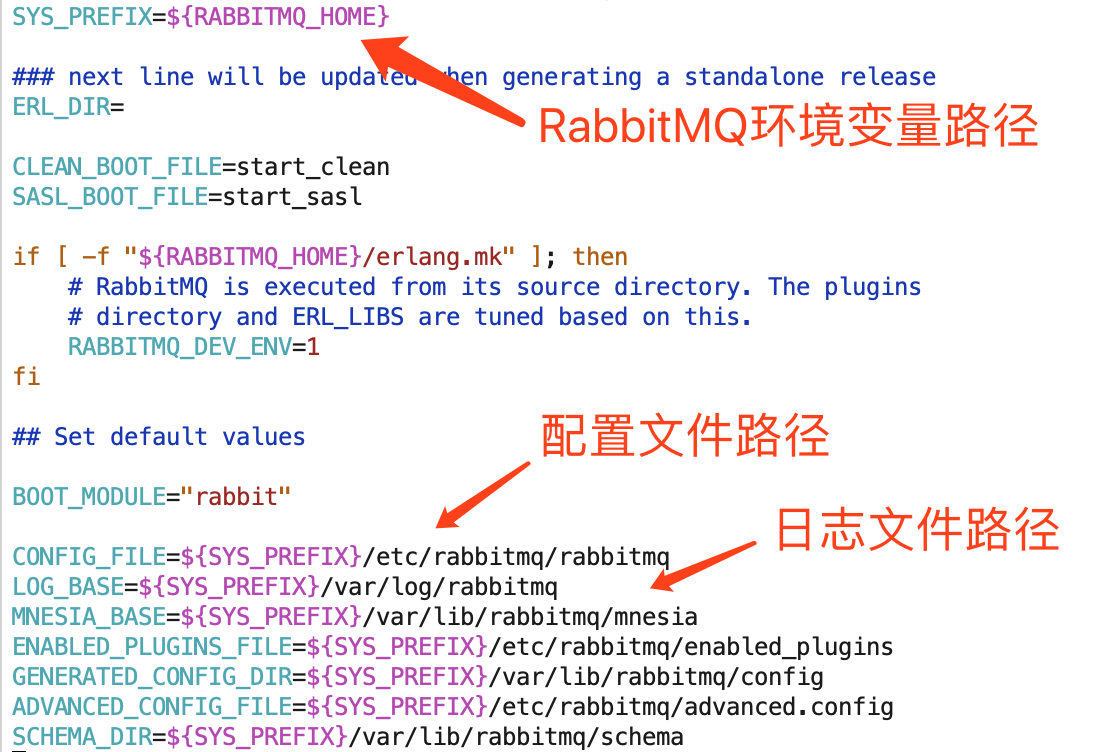
b、RABBITMQ_HOME是环境变量的位置,由上看出配置文件是/data/soft/rabbitmq_server-3.7.9/etc/rabbitmq/rabbitmq.conf(注意是rabbitmq.conf,不是rabbitmq,不知道为啥rabbitmq-defaults是rabbitmq),将模版改名为rabbitmq.conf,放入/data/soft/rabbitmq_server-3.7.9/etc/rabbitmq/下
c、在配置文件rabbitmq.conf中,增加内容或去掉注,改成为
loopback_users.guest = false
9、修改配置文件后重新启动RabbitMQ服务,浏览器输入http://ip:15672,进入web控制台。

【RabbitMQ】 RabbitMQ安装的更多相关文章
- RabbitMQ的安装过程
原创文章转载请注明出处:@协思, http://zeeman.cnblogs.com 网上一些安装教程都较为繁琐,实际上只需要两个RPM包,几分钟即可完成一台实例部署. 准备下载Erlang包: ht ...
- RabbitMQ服务安装配置
RabbitMQ是流行的开源消息队列系统,是AMQP(Advanced Message Queuing Protocol高级消息队列协议)的标准实现,用erlang语言开发.RabbitMQ据说具有良 ...
- Erlang&RabbitMQ服务安装配置
RabbitMQ是流行的开源消息队列系统,是AMQP(Advanced Message Queuing Protocol高级消息队列协议)的标准实现,用erlang语言开发.RabbitMQ据说具有良 ...
- RabbitMQ的安装
随笔记下Rabbit的环境搭建 1.下载RabbitMQ:RabbitMQ下载地址 Windows下安装 <1>安装Erlang 下载地址:Erlang下载 安装: Erlang安装完成 ...
- rabbitMQ第一篇:rabbitMQ的安装和配置
在Windows下进行rabbitMQ的安装 第一步:软件安装 如果安装rabbitMQ首先安装基于erlang语言支持的OTP软件,然后在下载rabbitMQ软件进行安装(安装过程都是下一步,在此不 ...
- Linux下 RabbitMQ的安装与配置-3
一 Erlang安装 1.RabbitMQ是基于Erlang的,所以首先必须配置Erlang环境. 从Erlang的官网http://www.erlang.org/download.html 下载最 ...
- 【linux环境下】RabbitMq的安装和监控插件安装
[注意安装过程中,提示某些命令not found,直接yum isntall一下就好了] 以下是我在CentOS release 6.4下亲测成功的. RabbitMq的安装: RabbitMQ是 ...
- 【windows环境下】RabbitMq的安装和监控插件安装
RabbitMq的安装: RabbitMQ是基于Erlang的,所以必须先配置Erlang环境. 下载Erlang,地址:http://www.erlang.org/download/otp_win3 ...
- gcc, numpy, rabbitmq等安装升级总结
1. 公司在下面目录安装了gcc-4.8.2,以支持c++11,可以通过在bashrc中添加来实现: PATH=/opt/compiler/gcc-4.8.2/bin:$PATH 2. 公司环境切换到 ...
- Linux下 RabbitMQ的安装与配置
以下教程摘录自互联网并做了适当修改,测试的rabbitmq 版本为:rabbitmq-server-generic-unix-3.5.6 各版本之间会有差异!!! 一 Erlang安装 Rabbit ...
随机推荐
- https方式下 git push 每次都要输入密码的解决办法
转载自:http://git.oschina.net/oschina/git-osc/issues/2586 作者:Zoker https方式每次都要输入密码,按照如下设置即可输入一次就不用再手输 ...
- SIGTERM、SIGKILL、SIGINT和SIGQUIT的区别
转自:http://blog.csdn.net/dai_xiangjun/article/details/41871647 SIGQUIT 在POSIX兼容的平台,SIGQUIT是其控制终端发送到进程 ...
- redis主从复制踩到的那些坑
一.报错:* MASTER <-> SLAVE sync started # Error condition on socket for SYNC: No route to host解决: ...
- Jenkins+sonar7.3集成
Jenkins安装请参考:https://blog.csdn.net/CheNorton/article/details/50327825?utm_source=copy Jenkins更新请参考:h ...
- AJAX模板
$.ajax({ type:"",//Ajax请求的提交方式(GET或POST) dataType:"text",//请求的类型 url:"" ...
- Karma - MVC Framework for Unity3D
Karma is an MVC framework for Unity3D. Because of how Unity is structured, it actually turns out to ...
- use crunch compression
Crunch is a lossy compression format on top of DXTR texture compression. Textures will be converted ...
- http://www.bugku.com:Bugku——PHP伪协议+魔幻函数+序列化的综合应用(http://120.24.86.145:8006/test1/)
这一道题目,幸好俺有基础知识护体,不然还真干不掉. 首先,登录看题目,取消隐藏代码的注释.可知可输入三个参数txt.file和password并进行逻辑判断:应该让txt==‘welcom ...
- 【linux】进程状态
[进程状态转移图] PROCESS STATE CODES R running or runnable (on run queue) D uninterruptible sleep (usually ...
- 使用go语言的list实现一个简单的LRU缓存
package main; import ( "container/list" "errors" "sync" "fmt" ...
